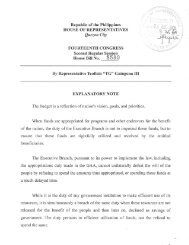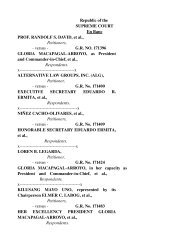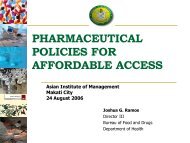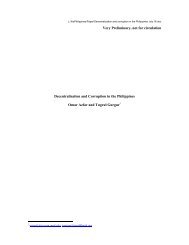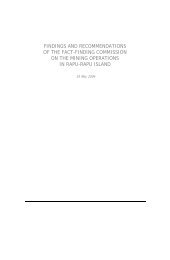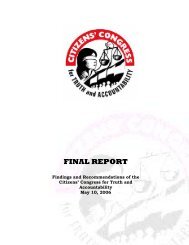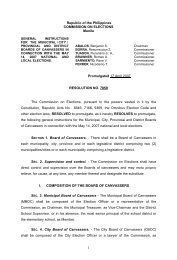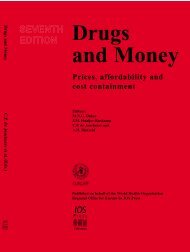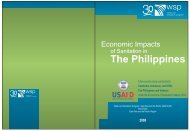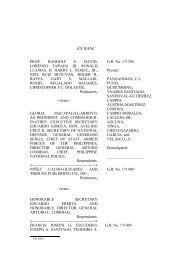The state of water resources in the Philippines - Greenpeace
The state of water resources in the Philippines - Greenpeace
The state of water resources in the Philippines - Greenpeace
You also want an ePaper? Increase the reach of your titles
YUMPU automatically turns print PDFs into web optimized ePapers that Google loves.
A study by <strong>the</strong> Japan International Cooperation Agency (JICA) conducted <strong>in</strong> 2001<br />
(as cited <strong>in</strong> National Economic Development Authority’s document on <strong>the</strong><br />
Medium Term Philipp<strong>in</strong>e Development Plan 2004-2010) <strong>state</strong>s that around 700<br />
<strong>in</strong>dustrial establishments <strong>in</strong> <strong>the</strong> Philipp<strong>in</strong>es generate about 273,000 tons <strong>of</strong><br />
hazardous wastes per annum. It was fur<strong>the</strong>r estimated that with 5,000 potential<br />
hazardous waste generators, about 2.41 million tons <strong>of</strong> hazardous wastes will be<br />
generated.<br />
At present, <strong>the</strong> report added, <strong>the</strong>re is no <strong>in</strong>tegrated treatment facility for<br />
hazardous wastes <strong>in</strong> <strong>the</strong> country although <strong>the</strong>re are about 95 small to mediumscale<br />
treatment facilities that treat hazardous wastes (i.e., used oil, sludge).<br />
<strong>The</strong>re is approximately 50,000 tons <strong>of</strong> hazardous wastes stored on or <strong>of</strong>fsite due<br />
to lack <strong>of</strong> proper treatment, recovery and recycl<strong>in</strong>g facilities. Sometimes <strong>the</strong>y end<br />
up be<strong>in</strong>g recycled <strong>in</strong> backyard operations fur<strong>the</strong>r putt<strong>in</strong>g at risk workers and<br />
communities host<strong>in</strong>g <strong>the</strong>se <strong>in</strong>formal recycl<strong>in</strong>g facilities. O<strong>the</strong>r hazardous wastes<br />
are exported to o<strong>the</strong>r countries for recovery and disposal (i.e. metal bear<strong>in</strong>g<br />
sludge, used solvents and electronic wastes) and treatment (e.g. PCB).<br />
Non-po<strong>in</strong>t sources<br />
Data on <strong>water</strong> pollution from non-po<strong>in</strong>t sources are <strong>of</strong>ten excluded <strong>in</strong> terms <strong>of</strong><br />
<strong>of</strong>ficial statistics. <strong>The</strong> PEM 2003 even mentions that <strong>the</strong> technology to monitor<br />
and control po<strong>in</strong>t sources has been well developed, while non-po<strong>in</strong>t sources are<br />
found to be difficult to monitor and control.<br />
If solid waste, for <strong>in</strong>stance, is not collected, treated and disposed properly, <strong>the</strong><br />
organic and toxic components <strong>of</strong> household, <strong>in</strong>dustrial, and hospital waste are<br />
mixed with ra<strong>in</strong> and ground<strong>water</strong>. It has also been established that this creates<br />
an organic and <strong>in</strong>organic mixture, composed <strong>of</strong> heavy metals and poly-organic<br />
and biological pathogenic tox<strong>in</strong>s, which causes illness and even deaths (PEM,<br />
2001).<br />
However, monitor<strong>in</strong>g <strong>of</strong> non-po<strong>in</strong>t sources, especially <strong>the</strong> contribution <strong>of</strong> solid<br />
waste, is scarce, and no attempt has been made thus far to create an <strong>in</strong>ventory.<br />
<strong>The</strong> common non-po<strong>in</strong>t sources are urban run<strong>of</strong>f and agricultural run<strong>of</strong>f (PEM,<br />
2003; EMB, 2006).<br />
Table 4 (shown <strong>in</strong> next page) illustrates <strong>the</strong> distribution <strong>of</strong> BOD generation for <strong>the</strong><br />
different regions. As shown <strong>in</strong> this table, reduced quality <strong>of</strong> <strong>water</strong> <strong>resources</strong> had<br />
been observed especially <strong>in</strong> densely populated areas, and regions <strong>of</strong> <strong>in</strong>dustrial<br />
and agricultural activities.<br />
In both reports (PEM 2003, EMB 2006), four regions were found to have an<br />
unsatisfactory rat<strong>in</strong>g for <strong>the</strong> <strong>water</strong> quality criteria. <strong>The</strong>se <strong>in</strong>clude <strong>the</strong> National<br />
Capital Region (NCR) or Metro Manila, Sou<strong>the</strong>rn Tagalog Region (Region IV),<br />
Central Luzon (Region III), and Central Visayas (Region VII). <strong>The</strong> Ilocos region<br />
(Region I) is also highlighted <strong>in</strong> this table as it is one <strong>of</strong> <strong>the</strong> highest contributors to<br />
agricultural BOD generation.<br />
GREENPEACE | <strong>The</strong> <strong>state</strong> <strong>of</strong> <strong>water</strong> <strong>in</strong> <strong>the</strong> Philipp<strong>in</strong>es 20



